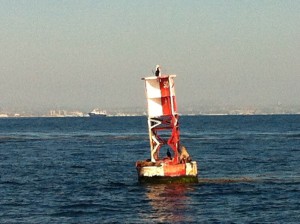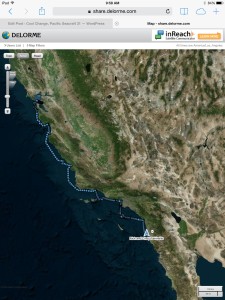The Oceanside sign visible upon entering behind the breakwater was a welcome sight. Oceanside’s entrance is a little like Morro Bay: if there is any sort of swell at all, the breakwater causes a type of surf “point break” just alongside where boats enter. It is a little intimidating to find yourself surfing into a narrow entrance, bordered by breakwaters! Because of indulging the night before at Avalon, we were both exhausted. The Yacht Club giving us reciprocal privileges of free dock space was just closing up for the night, so we showered and went back to the boat. I was up for nothing more than making a little dinner on the boat and going to bed, but since this was our only night in Oceanside, Rick wanted to take a walk around the marina district to find a nice restaurant. I acquiesced. Much to my delight, it was a healthy walk on a pleasant night and we found a comfortable restaurant along the water with outdoor seating and good food.
Oceanside is the kind of place that surprises you by its beauty. It was clean, with none of the graffiti expected for a place so close to L.A. The publicly owned marina was well designed, with lots of big benches, curved walkways and public fishing docks. Single women in their running shoes, and parents with strollers, were on the paths at night – always a good sign. But at the same time, it was not exclusive or pretentious; almost like it was trying to shake off a bad image rather than protect a glamorous one. We liked it.
The next day, we had our last 50 nm or so to go to get to San Diego, at last! San Diego was quite the milestone, as it is from here that we will start the rally called the Baja Ha Ha with 170 other boats down to Cabo San Lucas, leaving on October 27.
Also, it was my birthday, so Rick made me a fine breakfast underway.
It is tempting to cut the corner into San Diego, but we followed the guidebooks’ cautions to round the “SD” buoy before entering to avoid kelp, rock and surf.
That night, we met Frank and Susanne, with whom we sailed on last year’s Bsja HaHa, at the Red Sails restaurant where we first met. We celebrated Susanne’s and my birthdays and reminisced about our adventures.
After six weeks and 609 nautical miles so far with very few mishaps, I was starting to feel that all of this was too good to be true. When would the other shoe drop, so to speak? Well, and I can only speak of it now because everything seemed to turn out alright, I had a mishap when docking in San Diego. I had to back into a side tie on starboard bounded by a boat on one end and a perpendicular dock on the other, with the wind pushing the bow away from the dock. Not ideal conditions. My backing job was pretty good I thought, but I was still about 6 feet from the dock and my bow was getting pushed away as soon as I slowed. Rick tossed a midship line to a fellow sailor trying to help, who tied it off on the dock, but our bow was still swinging away, which brought our stern closer to the dock at an angle. The wind pushing the bow away, combined with the pivot point created by the line tied to the dock, resulted in a potentially dangerous situation of our stern pivoting into the dock and damaging Charlie, our Monitor Windvane hanging off the stern. But to make matters worse, I tried to use a maneuver to bring us closer to the dock that backfired because I hadn’t accounted for the effect the attached dock line would have, and sure enough, Our Windvane Charlie “bounced” off the dock. We somehow recovered, and once the boat was secured to the dock, Rick looked at Charlie and thought it was bent. I was hoping for the best and thought the touch was so light that surely nothing could have happened. I was wrong. Charlie’s gears were jammed together and wouldn’t move. A several thousand dollar piece of equipment broken, and no self-steering mechanism available for the long haul down to Mexico except our energy-hogging autopilot.
And it was my birthday! Rick was so upset he could hardly talk about it, saying only that there was no way he could do anything to fix it before we left. I was beating myself up thinking about what I could have done differently and realizing it was all upon me to find a solution. But we agreed to try and set the problem aside for the night in order to celebrate my birthday, and think about it again the next day.
So the next day I called the Monitor Windvane folks, who were quite helpful but really had no solution short of buying expensive parts that would take us days to figure out how to install. We weren’t even sure what parts were damaged without some professional help. Someone suggested I go to a welding shop, where one of the principals suggested I start by just pulling the Windvane in the opposite direction from which it was hit! But his suggested method to do so was a bit crude – tie a line from Windvane back to the dock and motor the boat in forward! I was skeptical, and knew Rick would never go for that. But it didn’t matter because the welding shop didn’t have time to come out to the boat anyway. So they introduced me to another shop, who didn’t have time either. Finally I strolled down to Downwind Marine, a local boating supply store, to ask them for a referral to a Windvane specialist. The owner came out from the back office, pointed to the customer standing at the counter next to me, and said, “he probably knows everything there is to know about Windvanes!”
The customer’s name was Captain Steve. We decided later it should have been something between Captain America and Popeye. He had logged 350,000 miles at sea. He was a small guy in his late 30’s who talked fast and had opinions about everything – very smart and a lot of energy. He was on his way to another project but said he could take a few minutes out to drive over to our boat and take a look. He came down to the dock ready to act, a few tools in hand. I introduced him to Rick. He looked at the Windvane, diagnosed exactly what had been bent, hooked up our 4-to-1 block and tackle to the Windvane and the dock, secured our boat to the dock, and gave the tackle a pull. The whole time his comments were so iconic that he almost seemed like a comic book hero, saying things like, “this is a job for Mr. Rolling Hitch. There are very few knots that deserve to be called Mr., but Mr. Rolling Hitch, like Mr. Prussic, deserve respect!” He checked the Windvane and pulled again. In less than 10 minutes, the Windvane was aligned and working perfectly. We couldn’t believe it. We gave him our cash on hand as a thank you, and off he went up the dock ramp. As he left, Rick called out to him, “where’s your cape?”
Unfortunately, our luck has been spotty in San Diego after that. I had an emergency root canal, a volunteer harbor policeman peeled out a neighboring patrol boat and came within inches of holing our boat, and someone stole our gas can and fuel line out of our dinghy. The facilities here are some of the least comfortable we have seen (for each gender separately, a single shower with a broken shower head holder, available only to boats at the dock, and two toilets open to the public, one of which was plugged up for a while in the women’s bathroom).
And then there has been the persistent problem of our wind speed indicator. It was brand new in May and seemed a little erratic from the beginning, like it hadn’t been calibrated. But then it got worse. Sometimes the speed wouldn’t read at all, and sometimes it would read way wrong (like 50 knots of wind when there were only 10). It should have been a warrantee repair, but the guy has been out almost every day trying to fix it, starting with the easiest solution first, and nothing worked. Finally, he figured out after replacing every other part that it was the cable that was faulty. This is a cable that runs down the mast and through a narrow compression post and tight corners up to the control box. Our installers must have screwed up somehow. The warrantee repair guy says he can’t get it done before we leave. So I guess we are going to Mexico without a wind speed indicator, and dealing with it in Mexico. We of course will never be able to collect on our warrantee work, and it is going to be a real hassle to fix, but oh well. At least it is not a critical piece of equipment; like they say, you don’t need to be a weatherman to know which way the wind blows!
Nevertheless, we have again met some wonderful people, including a lovely Chinese woman named Sandy and her husband Bruce who plan to cross to the South Pacific five months from now in a Hans Christian 33, a very heavy and solid boat. Sandy was a Chinese acrobat who traveled the world and is still very fit. I admire what it must have took to leave her culture behind – she says it was God’s will. She is very petite, and has the cutest dimples and the sweetest smile! She is an interesting cook and always dresses impeccably. He is just the opposite of her – a big, casual guy who is not too fond of detail. But he is a friendly guy, a good sailor and a loving husband and father who has helped raise her daughter. There are also a number of Canadians and Washington State boats docked around us going on the same trip, with big, sturdy boats and lots of experience. I feel in good company, with lots of people around who would help each other.
Anyway, we are finishing up the last details of our trip now. Sunday is the costume party attended by all 170 boats, and Monday morning is the boat parade and rally start. By late morning, we should be crossing the Mexican border and canceling all cell phone calls. After that, the only way to get in touch with us will be email, and not until we reach Cabo San Lucas and can get to an internet site. Watch us on our DeLorme map link on our blog as we travel down the undeveloped west coast of Baja. After stopping for a few days at two remote anchorages, we should arrive in Cabo San Lucas around November 7, and shortly after that, I hope to post another update. In the meantime, emergency contact in the form of a short text on our Delorme satellite system can be made to us through our sisters Linds or Sharon. Once we get to Mexico, we will explore other ways of keeping in touch, like Skype or Mexican phones.
Mexico or bust!





